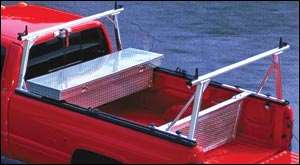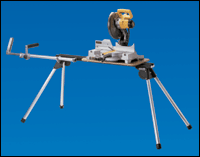Powder Coating Replaces Anodizing
You've all heard numerous conversion stories that detailed the transition from paint to powder. But, with the advent of chrome powder coatings, there's a new story to tell…
TracRac Inc. (Fall River, MA) is a manufacturer of a variety of products, including truck racks, van racks and portable workstations. However, the company is most known for the product that bears its name. This racking system, which can be purchased direct from automotive manufacturers or as an aftermarket product, attaches to the walls of a pickup truck using a patented system that requires no drilling or bolts.
To manufacture the racks, and its other products, TracRac purchases aluminum extrusions that it machines, cuts to length and welds together. Once the pieces are assembled, they are sent out to be bright dip anodized.
Featured Content
But, sending parts out to be anodized caused a number of problems for TracRac. The company found that the finish scratched too easily and limited its use of different substrates. Also, using two contract finishers (one for anodizing and the other for powder coating) meant that TracRac had to build more product than it really needed to be fully stocked due to the large amount of work continually being shipped between the three companies.
Having filled an entire warehouse with work-in-process, Tom Derecktor, president of TracRac, decided the company needed to make a change. Through Chrysler, one of TracRac's customers, Mr. Derecktor found out about a chrome powder coating, called Reflectra, that could be a possible replacement for the bright dip anodizing on the company's products.
So, Mr. Derecktor contacted the manufacturer of the chrome powder coating, H.B. Fuller, to learn more. One of the primary concerns for Mr. Derecktor was that the chrome powder coating provide the same metallic look that the bright dip anodizing did. After some extensive testing, Mr. Derecktor was more than satisfied with the chrome powder's high-gloss and metallic appearance.
Since TracRac had never performed any finishing operations, it then had to determine the best application method for the chrome powder coating. According to Mr. Derecktor, TracRac wanted the highest quality, most consistent system to coat aluminum parts.
As is the case with any coating, TracRac knew that the pretreatment was critical. Therefore, the company had H.B. Fuller work with four pretreatment suppliers to determine which coating system would provide the best results. After testing, TracRac installed a four-stage (strong acid, rinse, rinse, seal) pretreatment system from Ondeo Nalco that is capable of handling multiple metals. The double rinse allows TracRac to cut the amount of rinse water in half compared to a single rinse system, which is very important to due the strict environmental laws in Massachusetts.
Once it had decided on the pretreatment, TracRac began working with a number of suppliers (ITW Gema, Southern Finishing, Pacline and Deimco) to design a state-of-the-art application system. The load station on the line is located right next to the welding station so that parts can be immediately put on the system after welding. After pretreatment, the parts then travel through two powder coating booths, each with four automatic spray guns. The first spray booth is used to apply the chrome powder coating at a thickness of 1.5-2.0 mils (or a black powder to some parts). The chrome powder coating is then cured. Parts then travel through a second spray booth that applies a clear powder coating to all parts at 1.0-1.5 mils. TracRac applies the clear powder coating to double the UV and salt spray resistance of the parts and enhance the depth of the finish. After receiving the clearcoat, parts go through a second cure oven. Then they are unloaded and packaged for shipping.
 |
The switch to the chrome powder coating and the move to bring the powder coating process in house have provided a number of benefits to TracRac. One of the most significant benefits is a change in the company's welding process. Before it began using the chrome powder, TracRac used a manual TIG welding process to accommodate the anodized finish required on the parts. While the TIG welding process produced good parts, Mr. Derecktor wanted to switch to an automated MIG welding process, but the company was unable to do this as long as the parts were anodized because MIG welding would discolor the anodized finish. However, with the use of the chrome powder, TracRac was able to install a robotic MIG welding machine that is six times faster than the TIG welding process. Not only is the robotic MIG welder faster, but it produces a higher quality, more consistent weld as well. The process has become more efficient too; setup time has been reduced from two weeks to one day. Plus, the MIG welding process allows TracRac to use higher strength aluminum alloys, improving the durability of its products.
Another benefit of the move to the chrome powder was reduced work-in-process. As noted previously, when TracRac subbed out the finishing of its product to an anodizer (which, according to Mr. Derecktor, was the only anodizer in the region) and a powder coater, it was required to build more product than necessary so that it always had product ready to be shipped when the company's customers called. In fact, TracRac had a whole building used to store work-in-process. Initially, TracRac looked at bringing both the anodizing and powder coating process in house, but the company quickly learned that building an anodizing line could not be justified under Massachusetts environmental laws. So the chrome powder coating allowed the company to eliminate the anodizing process altogether and bring the entire powder coating process in house. Now that it doesn't have to ships parts to two different job shops for finishing, TracRac has reduced it's work-in-process by 80%, and the building that was originally used to store the work-in-process now houses the powder coating system.
In addition to reducing the work-in-process, the chrome powder coating provides a superior finish, according to Mr. Derecktor. When parts were anodized, they were easily scratched, and the parts sometimes showed faint lines in the aluminum that resulted from the extrusion process. The chrome powder has proven to be more scratch resistant as well as UV resistant. And, it maintains the metallic look that Mr. Derecktor feels is important for TracRac's products.
Clearly, what was once a major headache is now a source of opportunity for TracRac. Not only has the company dramatically improved its manufacturing process, but it also is looking into adding a second and third shift to the powder coating line to do outsource work.
RELATED CONTENT
-
Masking for Surface Finishing
Masking is employed in most any metal finishing operation where only a specifically defined area of the surface of a part must be exposed to a process. Conversely, masking may be employed on a surface where treatment is either not required or must be avoided. This article covers the many aspects of masking for metal finishing, including applications, methods and the various types of masking employed.
-
Touch-up Options for Powder Coated Parts
Is it true that powder coating cannot be touched up? Powder coating expert Rodger Talbert offers options for powder coating touch-ups.
-
The Powder Coating Process
Powder coating is one of the most durable finishes that can be applied to industrial manufactured products, and offers excellent corrosion protection and is very safe because of its lack of volatile organic compounds. To understand the powder coating process you should start with the fundamentals.


.JPG;width=70;height=70;mode=crop)


















